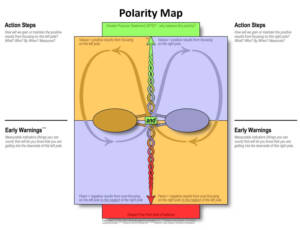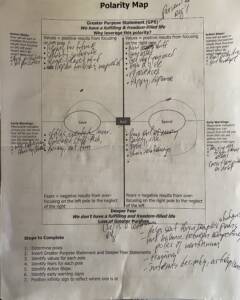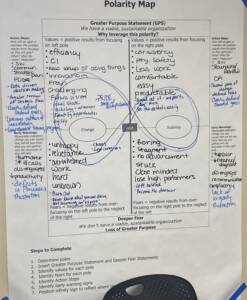
Polarity Thinking: Finding the Balance in Everything — Oct 2023
October 23, 2023
Life is about paradoxes: sickness versus health; richer versus poorer; hot versus cold; better versus worse; happy versus sad. The same is true in our organizations: success versus failure; growth versus contraction; centralization versus decentralization; efficiency versus innovation. The truth, of course, is that these poles are not binary — they’re all on a continuum, and the issues surrounding the paradoxes need to be understood, weighed, and balanced to create harmony.
Last month, one of PEN’s members hosted a benchmarking visit for another member to explore best practices in leadership, strategy, and operations. In that day of learning, I was made aware of a concept called Polarity Thinking, a powerful tool to build leadership capacity. In general, polarity is defined as “the state of having two opposite or contradictory tendances, opinions or aspects.” Polarity Thinking, then, is building the capacity to see the “both/and” in situations — the value or benefits of seemingly contrasting issues. Indeed, life is full of competing ideas — tensions between one thing and another. And we have been taught to make choices between the options. But in reality, these issues could be polarities that are interdependent on each other, and the “choice” may be somewhere in the middle — not one or the other.
 Think about polarities in business: change versus stability; mission versus margin; optimism versus pragmatism; save/invest versus spend/consume. Throughout our careers, we’re often taught to manage these tensions or dilemmas — to “solve the problem” and pick a side. The issue with cut-and-dried problem solving, though, is that oftentimes there isn’t just one solution, but a range of solutions that each carry benefits and drawbacks. Polarity is a dilemma that is ongoing, oftentimes unsolvable, and contains seemingly opposing perspectives that are usually interdependent. For example, in business (or personally), you shouldn’t save 100% of your money and you shouldn’t spend 100% of your money — the “answer” is usually somewhere in the middle (and could change over time with shifting variables). One cannot solve a polarity by making a choice: indeed, all polarities contain two pairs of truth that need each other over time.
Think about polarities in business: change versus stability; mission versus margin; optimism versus pragmatism; save/invest versus spend/consume. Throughout our careers, we’re often taught to manage these tensions or dilemmas — to “solve the problem” and pick a side. The issue with cut-and-dried problem solving, though, is that oftentimes there isn’t just one solution, but a range of solutions that each carry benefits and drawbacks. Polarity is a dilemma that is ongoing, oftentimes unsolvable, and contains seemingly opposing perspectives that are usually interdependent. For example, in business (or personally), you shouldn’t save 100% of your money and you shouldn’t spend 100% of your money — the “answer” is usually somewhere in the middle (and could change over time with shifting variables). One cannot solve a polarity by making a choice: indeed, all polarities contain two pairs of truth that need each other over time.
So how can the concept of Polarity Thinking help us as leaders? The more I’ve read and reflected on this concept, the more I think it helps leaders in three main ways. It helps leaders: 1) develop an ability to be able to sit with seemingly opposing ideas, 2) make better decisions, and 3) more effectively navigate complexity. It can help us in negotiations; it can help us find positions that benefit all parties (true “win-win” outcomes); it can help us develop personal and organizational resilience; it can help us manage change. For example, leaders need to understand and weigh the impact of pushing for a certain change versus the preference of some of their team members for safety and stability — a real and frequent tension in today’s organizations.
To embrace Polarity Thinking, one should create a Polarity Map. And here is a simple process for doing so:
- Determine poles.

- Insert a “Greater Purpose Statement” (a personal or professional statement that describes why it is important to leverage this particularly polarity) and a “Deeper Fear Statement” (a statement that captures loss of the Greater Purpose).
- Identify “values” for each pole – those positive results from focusing on one pole and the other.
- Identify “fears” or drawbacks for each pole – those negative results from over-focusing on one pole to the neglect of the other pole.
- Identify “action steps” for each pole, which answers the question “how will we gain or maintain the positive results from focusing on a pole?”
- Identify “early warning signs” for each pole – measurable indicators (things you can count) that will let you know that you are getting into the downside of each pole.
- Position an infinity sign to reflect the current reality – are the poles in balance or tilted one way or the other?
 Here are two sample Polarity Maps, the first on “Save” and “Spend” as well as one our member
Here are two sample Polarity Maps, the first on “Save” and “Spend” as well as one our member completed on “Change” and “Stability.” Reflecting on the values (pros) and fears (cons), you can see the tension and complexity between those two notions. And the simple process of having a conversation with your team about factors surrounding this set of poles helps you: 1) sort through complex situations; 2) better frame and describe the issue; 3) explore the balance (or imbalance) between seemingly competing poles; and 4) make better decisions and take action to shift the current reality to a more desired one.
completed on “Change” and “Stability.” Reflecting on the values (pros) and fears (cons), you can see the tension and complexity between those two notions. And the simple process of having a conversation with your team about factors surrounding this set of poles helps you: 1) sort through complex situations; 2) better frame and describe the issue; 3) explore the balance (or imbalance) between seemingly competing poles; and 4) make better decisions and take action to shift the current reality to a more desired one.
Smith, Lewis and Tushman in their 2016 Harvard Business Review article “Both/And Leadership” outlined three key shifts in mindset that leaders need to bring to these paradoxical challenges:
- From well-intentioned consistency to consistent inconsistency — when two seemingly contradictory objectives present themselves (like maximizing shareholder value versus social responsibility), avoid the temptation to pick a side. Instead, embrace both “truths” and manage the tension between them.
- From scarce resources to abundant resources — think beyond normal constraints to find the means to create value from a broader set of alternatives (for example, could you leverage the resources of partners or explore alternative technologies like artificial intelligence).
- From stability and certainty to dynamism and change — let go of the expectation that stable certainty is the norm, and instead lean into ambiguity and promote experimentation.
According to Kimberly Braxton and Pilar Mendoza in their November 2021 article, here are a few final thoughts — tips — for recognizing and navigating polarities:
- Arguments (personal or professional) are often grounded in polarities. Seek to understand the roots of the tension.
- Seek awareness of polarities. Polarities do not always present themselves neatly, so explore the dynamics between these choices in a systematic way (like with the Polarity Map).
- Polarity management means embracing “yes and” rather than “either/or.” Typically, there is no single right answer.
- Think about how one polarity works with another to create harmony and balance: what are the upsides and downsides of each?
- Understand the greater purpose when you are managing a polarity. Answer the question “how can we move forward together with an overarching, unified purpose?”.
Polarity is everywhere — you really can’t avoid it. But you can better understand it, frame it, manage it, and navigate your way through it.
What comments do you have regarding polarity thinking? Participate in a discussion on this topic: visit our LinkedIn group to post a comment. And follow me on Twitter @LassiterBrian!
Yours in Performance Excellence,
Brian S. Lassiter
President, Performance Excellence Network
www.performanceexcellencenetwork.org
Catalyst for Success Since 1987!
Photo credit integrallife.com, elsevier.com

